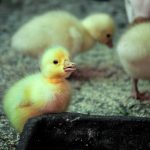Ducks have been an integral part of Indian agriculture and culture for centuries. Domestic duck breeds in India are diverse and have been bred for various purposes, including meat, eggs, and pest control. The rearing of ducks is a common practice in rural and urban areas, and it plays a significant role in the livelihoods of many people. The diversity of domestic duck breeds in India reflects the country’s rich agricultural heritage and the importance of ducks in sustaining rural economies.
Domestic duck breeds in India are known for their adaptability to various climatic conditions and their ability to thrive in both rural and urban settings. They are an important source of protein for many households, especially in regions where access to other sources of animal protein is limited. In addition to their role in food production, domestic ducks also provide valuable services such as pest control in rice fields and the production of high-quality feathers for pillows and mattresses. The popularity of domestic duck breeds in India is also attributed to their low maintenance requirements and their ability to forage for food, making them a cost-effective option for small-scale farmers.
Table of Contents
- 1 Popular Duck Breeds in India
- 2 Characteristics and Traits of Indian Domestic Duck Breeds
- 3 Uses and Benefits of Domestic Ducks in India
- 4 Breeding and Rearing Practices for Indian Domestic Duck Breeds
- 5 Challenges and Issues Facing Domestic Duck Breeds in India
- 6 Conclusion and Future Outlook for Domestic Duck Breeds in India
- 7 FAQs
- 7.1 What are domestic duck breeds in India?
- 7.2 What are the characteristics of domestic duck breeds in India?
- 7.3 What are the uses of domestic duck breeds in India?
- 7.4 What are the popular breeds of domestic ducks for meat production in India?
- 7.5 What are the popular breeds of domestic ducks for egg production in India?
- 7.6 What are the challenges in raising domestic duck breeds in India?
Key Takeaways
- Domestic duck breeds in India have been an integral part of rural households for centuries, providing meat, eggs, and feathers.
- Popular duck breeds in India include the Khaki Campbell, Indian Runner, White Pekin, and Desi ducks, each with unique characteristics and traits.
- Indian domestic duck breeds are known for their adaptability to local climates, high egg production, and ability to forage for food.
- Domestic ducks in India are used for meat, egg production, pest control, and as a source of organic fertilizer for agriculture.
- Breeding and rearing practices for Indian domestic duck breeds involve providing proper housing, nutrition, and healthcare, as well as ensuring access to water for swimming and foraging.
Popular Duck Breeds in India
There are several popular domestic duck breeds in India, each with its own unique characteristics and traits. One of the most popular breeds is the Khaki Campbell, known for its high egg production and excellent foraging abilities. The Khaki Campbell is a dual-purpose breed, valued for both its meat and eggs, making it a popular choice for small-scale farmers. Another popular breed is the Indian Runner, which is known for its upright posture and exceptional egg-laying capabilities. Indian Runners are often used for pest control in rice fields due to their ability to consume large quantities of insects and snails.
The White Pekin is another popular domestic duck breed in India, prized for its fast growth rate and high meat yield. This breed is commonly raised for meat production and is known for its tender and flavorful meat. The Aylesbury duck is also popular for meat production, known for its white plumage and excellent meat quality. In addition to these breeds, the local desi ducks are also widely raised in India, valued for their adaptability to local conditions and their ability to thrive in free-range systems. These popular domestic duck breeds in India play a crucial role in meeting the country’s demand for meat and eggs while also providing valuable services such as pest control and feather production.
Characteristics and Traits of Indian Domestic Duck Breeds
Indian domestic duck breeds exhibit a wide range of characteristics and traits that make them well-suited for various purposes. Many of these breeds are known for their high egg production, with some individuals laying up to 300 eggs per year. The Khaki Campbell, Indian Runner, and White Pekin are all renowned for their exceptional egg-laying capabilities, making them valuable assets for small-scale farmers and commercial producers alike. In addition to their egg-laying abilities, these breeds also exhibit rapid growth rates, making them ideal for meat production.
The adaptability of domestic duck breeds in India is another notable trait, as they are able to thrive in diverse climatic conditions and environments. This adaptability makes them well-suited for free-range systems, where they can forage for food and contribute to pest control efforts. Furthermore, many Indian domestic duck breeds are known for their calm and docile nature, making them easy to handle and manage. Their ability to coexist with other livestock species also makes them a valuable addition to mixed farming systems. Overall, the characteristics and traits of Indian domestic duck breeds make them versatile and valuable assets for food production and agricultural sustainability.
Uses and Benefits of Domestic Ducks in India
Domestic ducks in India serve a variety of uses and provide numerous benefits to farmers and rural communities. One of the primary uses of domestic ducks is the production of meat and eggs, which contribute to food security and nutrition. Ducks are a good source of lean protein, and their eggs are highly nutritious, containing essential vitamins and minerals. In addition to their role in food production, domestic ducks also provide valuable services such as pest control in rice fields, where they consume insects and snails that can damage crops.
The feathers of domestic ducks are also used in various industries, particularly in the production of pillows, mattresses, and winter clothing. Duck feathers are valued for their insulating properties and soft texture, making them a sought-after material for bedding and apparel. Furthermore, ducks play a role in nutrient cycling on farms, as they contribute to the decomposition of organic matter and the recycling of nutrients in agricultural systems. Their manure is also a valuable source of fertilizer, enriching the soil and improving crop yields. Overall, the uses and benefits of domestic ducks in India extend beyond food production and contribute to the sustainability of agricultural systems.
Breeding and Rearing Practices for Indian Domestic Duck Breeds
Breeding and rearing practices for Indian domestic duck breeds vary depending on the specific goals of the farmer or producer. In general, breeding programs focus on selecting individuals with desirable traits such as high egg production, rapid growth rates, and adaptability to local conditions. Breeding stock is carefully managed to maintain genetic diversity and improve overall productivity. In some cases, artificial insemination may be used to ensure controlled breeding and genetic improvement.
Rearing practices for domestic duck breeds in India also vary depending on the intended use of the ducks. For egg production, ducks are typically housed in well-ventilated shelters with access to water for swimming and foraging areas for natural feed sources. For meat production, ducks may be raised in semi-intensive or free-range systems, allowing them to graze on pasture and consume natural foods. Disease management and biosecurity measures are important aspects of rearing practices to ensure the health and welfare of the ducks. Overall, breeding and rearing practices for Indian domestic duck breeds aim to maximize productivity while ensuring the well-being of the ducks.
Challenges and Issues Facing Domestic Duck Breeds in India

Despite their numerous benefits, domestic duck breeds in India face several challenges and issues that impact their sustainability and productivity. One of the primary challenges is disease outbreaks, particularly avian influenza, which can have devastating effects on duck populations. Disease management and biosecurity measures are essential to prevent outbreaks and minimize the spread of infectious diseases among domestic duck flocks.
Another challenge facing domestic duck breeds in India is the lack of organized marketing channels and value chains for duck products. This can limit the economic opportunities for duck farmers and hinder the growth of the duck industry. Additionally, climate change and environmental degradation can impact the availability of natural feed sources for ducks, affecting their nutritional intake and overall productivity.
Furthermore, there is a need for improved research and extension services to support duck farmers with access to information on best practices, breeding techniques, disease management, and market opportunities. Capacity building among small-scale farmers can also help improve productivity and sustainability within the duck industry. Addressing these challenges will be crucial in ensuring the long-term viability of domestic duck breeds in India.
Conclusion and Future Outlook for Domestic Duck Breeds in India
In conclusion, domestic duck breeds play a vital role in Indian agriculture, providing valuable resources such as meat, eggs, pest control services, feathers, and nutrient cycling. The diverse characteristics and traits of Indian domestic duck breeds make them well-suited for various purposes, contributing to food security, rural livelihoods, and agricultural sustainability. However, challenges such as disease outbreaks, limited marketing channels, climate change, and knowledge gaps pose significant threats to the sustainability of domestic duck breeds in India.
Looking ahead, there is a need for concerted efforts to address these challenges through improved disease management strategies, enhanced marketing opportunities, climate-resilient farming practices, and capacity building among duck farmers. Research and extension services should focus on developing best practices for breeding, rearing, disease management, and market access. Strengthening value chains for duck products can create economic opportunities for small-scale farmers while promoting sustainable production practices.
Overall, the future outlook for domestic duck breeds in India hinges on collaborative efforts from government agencies, research institutions, extension services, non-governmental organizations, and private sector stakeholders to support the growth and sustainability of the duck industry. By addressing the challenges facing domestic duck breeds and leveraging their numerous benefits, India can ensure the continued contribution of ducks to agricultural development and rural livelihoods.
If you’re interested in learning more about domestic duck breeds in India, you may also want to check out an informative article on PoultryWizard about what to feed ducks to ensure their health and well-being. Understanding the dietary needs of ducks is crucial for their proper care and development. You can find the article here.
FAQs
What are domestic duck breeds in India?
There are several domestic duck breeds in India, including the Indian Runner, Khaki Campbell, White Pekin, and the local desi ducks.
What are the characteristics of domestic duck breeds in India?
Domestic duck breeds in India vary in size, color, and egg-laying capabilities. They are known for their adaptability to the Indian climate and their ability to thrive in both free-range and confined environments.
What are the uses of domestic duck breeds in India?
Domestic duck breeds in India are primarily raised for their meat and eggs. They are also used for pest control in rice fields and as pets.
What are the popular breeds of domestic ducks for meat production in India?
The Khaki Campbell and White Pekin are popular domestic duck breeds in India for meat production due to their fast growth and high meat yield.
What are the popular breeds of domestic ducks for egg production in India?
The Indian Runner and Khaki Campbell are popular domestic duck breeds in India for egg production, as they are known for their high egg-laying capabilities.
What are the challenges in raising domestic duck breeds in India?
Challenges in raising domestic duck breeds in India include proper housing, disease management, and ensuring access to clean water and suitable feed. Additionally, predators can pose a threat to domestic ducks in free-range environments.
Meet Walter, the feathered-friend fanatic of Florida! Nestled in the sunshine state, Walter struts through life with his feathered companions, clucking his way to happiness. With a coop that’s fancier than a five-star hotel, he’s the Don Juan of the chicken world. When he’s not teaching his hens to do the cha-cha, you’ll find him in a heated debate with his prized rooster, Sir Clucks-a-Lot. Walter’s poultry passion is no yolk; he’s the sunny-side-up guy you never knew you needed in your flock of friends!







